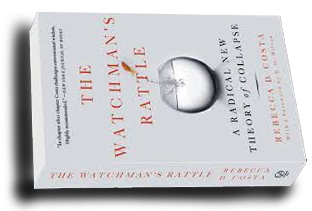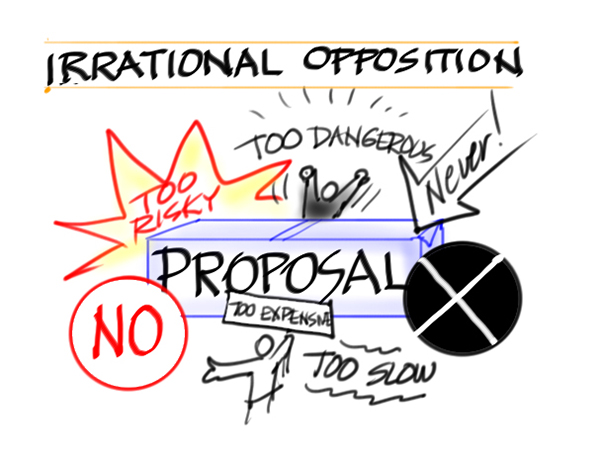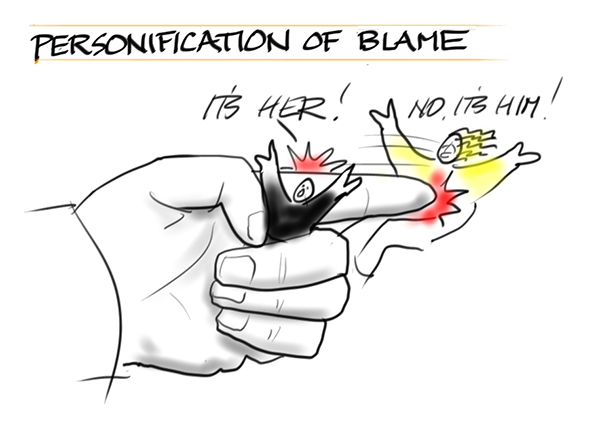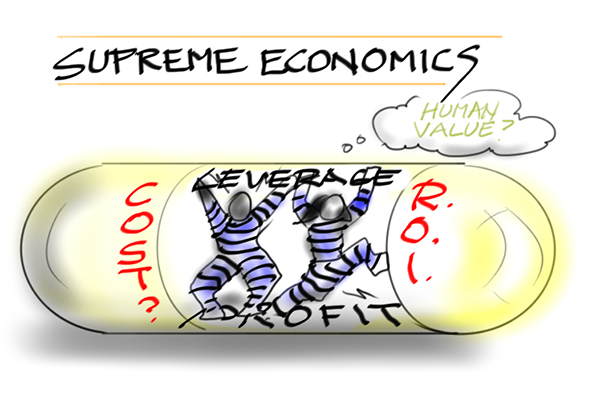
A Radical New Theory of Collapse
I sustain a keen interest in metaphors and plausible narratives about where we are headed as a society, and frankly, I am worried. I was rocked recently by a close reading of sociobiologist and futurist Rebecca Costa’s 2012 best seller, The Watchman’s Rattle: A Radical New Theory of Collapse. (She has a new book, also a best seller, called On the Verge, which I haven’t read.) Costa has a long history in Silicon Valley and a polymath’s appetite for large-scale thinking. My reading, in the context of seeing our country spiraling into policy chaos, is that her 2012 message is even more relevant in 2018.
2012 best seller, The Watchman’s Rattle: A Radical New Theory of Collapse. (She has a new book, also a best seller, called On the Verge, which I haven’t read.) Costa has a long history in Silicon Valley and a polymath’s appetite for large-scale thinking. My reading, in the context of seeing our country spiraling into policy chaos, is that her 2012 message is even more relevant in 2018.
Her “new theory” is that civilizations collapse when complexity outstrips human’s cognitive ability to grasp what is going on. More interestingly, she identifies the symptoms that suggest collapse is beginning. I’m not wanting to believe we are collapsing, as I am much more interested in growth and development and what our field of process consulting and visual practice can do in response. Yet her argument is persuasive.
Let me summarize what she is talking about. Drawing from both evolutionary biology and new findings in neuroscience, Costa describes in detail how the Mayans, Romans, Germans and others expanded and collapsed. Collapse begins with gridlock—simply too many conflicting forces and events compounding—and continues with the substitution of belief for facts.
In most civilizations, Costa observes, there is a balance between untethered beliefs and scientifically or experientially validated knowledge. We use beliefs to deal with the ineffable and non-objective, and we have (at least for the last many hundreds of years) looked to science for help with being objective, particularly regarding the physical world. Yet when complexity begins to overwhelm people’s cognitive abilities, beliefs take over and attention to facts disappears.
For the Mayans facing severe drought, their engineering of cisterns and other water strategies gave way to human sacrifice. For the Germans after World War I, the complexity of their post-war fractured economy gave way to fascism and blame and World War II. Sound familiar?
Five Memes
As beliefs begin to supersede fact-based knowledge, some of these beliefs develop a viral power and become what Costa calls “super memes.” (Memes, as you may well know, are thought forms that propagate via human brains. They function a lot like viruses, jumping from host to host). Super memes become unquestioned frames of reference.
I created the following working illustrations of these five super memes to plant them in my memory:
- Irrational Opposition: It is okay or even virtuous to oppose things because you don’t like them, and you bear no responsibility for providing any possible alternate solution.

- Personification of Blame: When things aren’t working, blame individuals and ignore system dynamics and multiple causation—and definitely don’t spend time on research or actually trying to increase your understanding of the situation.

- Counterfeit Correlations: Forget real science; if two data streams follow a similar pattern, they must be causally related. For example: cell phone use by teens is increasing. Teen suicides are increasing. Therefore cell phones must cause suicide. While this is completely bogus science, it is pervasively passing as science in many quarters, according to Costa.

- Silos: It is to be expected that people will stay inside the comfort of their own discipline, function, and culture, not sharing with others—especially those who are different. Costa’s most chilling examples are from the “health care” system.

- Supreme Economics: The only true value is economic value: ROI, leverage, and profitability. Thinking of people as resources that have to be managed is practical and necessary. Caring about intrinsic human values is for people who aren’t realistic.

Looking and listening to the news through these lenses is sobering. How much reporting goes on that is outside these frames? How firmly are these “super memes” embedded in our institutions? How much of their increasing virility is being fueled by our social system becoming truly overwhelmed? Even more cynically, how much of the complexity, overwhelm, and confusion that seems to be growing is being purposely fostered to drive people to beliefs over facts? (Or am I now personifying blame?)
Hopeful Strategies
In the last part of her book Costa reviews strategies for increasing cognitive capability as a potential response, perhaps hanging on to the modernist dream that thought will prevail, and tiptoeing into the role of insight (as opposed to either logical or analogical thinking) and the domain of mindfulness strategies as ways of finding deeper guidance.
Her conclusion—that collapse is connected to cognitive overload on a social scale—resonated with work I’ve been doing with Mary Gelinas, one of our GLEN (Global Learning & Exchange Network) colleagues, on the Neuropsychology of Collaboration. Mary appreciates that fear and threat neurologically shut down our executive function and interfere with our ability to innovate and problem-solve. We held a set of three GLEN Exchanges last month, and Mary wants to push ahead with a book on the subject. I have also worked with Bill Bancroft, another GLEN colleague who is digging deeply into the same areas. Bill led a couple of exchanges on the Neuropsychology of Design Thinking, exploring why being playful and exploratory is so helpful.
Costa’s ideas lend even more credence to the idea Gisela Wendling and I are bringing forward in Visual Consulting: Designing & Leading Change (now finished and due out in September)—that we need to pay as much attention our inner dynamics and capabilities as we do to outer support structures and technique when we are leading change.
I’d love to get responses to these ideas. I’m considering opening up a more serious exploration in The GLEN to do some real collective wisdom exercises around Costa’s central thesis, and I definitely will read her second book.
I pursue all these explorations being fascinated with cognition, and am beginning to think it might have some bearing on our survival. If increasing cognitive capability in people and groups is an important response to our global predicament, then there is a huge potential role for those of us who work as visual process consultants.







Julia Tunariu
July 23, 2018Thank you David for this article. We need people like you to help bring light into our “dark mental world” and I “believe” that joined forces in that direction would allow us to extinguish the fear of life/fear of death (the virus that spoils our lives and causes all suffering).
For a deeper exploration, please allow me to share two contacts:
John Sherman from JustOneLook.org (former RiverGanga) and Hale Dwoskin (The Sedona Method).
John Sherman has come to an extremely simple suggestion which has the power to extinguish this fundamental fear. He suggests and act (“practice”) which would allow us, (humanity), to move to a different level quite fast if enough people would overcome this primitive energy blocker (called fear) (see The 100th monkey jump in consciousness experiment). Hale Dwoskin is also an incredible person to talk to. He brought the Sedona Method to an unprecedented master level. I believe that connecting with them, will be a high experience.
Trix
July 27, 2018Plneaisg to find someone who can think like that
Lion Goodman
July 22, 2018This article is my first contact with you, your organization, and your thoughts. It is clear and well-reasoned. I, too, am a synthesist, bringing together cognitive neuroscience, positive psychology, an understanding of beliefs (and memes, whatever you call them), and a very practical approach to changing beliefs at the individual level. It’s been more difficult to see ways to change beliefs at the collective level, which is where so many problem lie. It seems that many of us are trying to get our hands around this. My favorite book of late is one I’m recommending to everyone, because it speaks to the individual AND the collective belief-structure, is “The Patterning Instinct” by Jeremy Lent. Lent is a true scholar, bringing together information from all the areas we both are attracted to – including the development of memes across history and civilizations. I recommend it to you and to all your readers. And I look forward to reading more about your work.
Julie Stuart
July 22, 2018Increased cognition can only do so much if its not coupled with the body & emotions, Somehow we need to develop increased empathy for one another, experience more honesty and vulnerability around each other’s difference to create inclusion and invite collaboration and trust. The thinking mind will only get us so far. This is relational work and why I feel like the wisdom of the body will lead us forward and toward one another. Here’s a post from a movement medicine teacher of mine that relates the rhythms of our 5 Rhythms practice to where we are now–in the rhythm of Chaos–and how to navigate it: http://www.adambarley.com/chaos-has-barely-started/
Sharon Swing
July 21, 2018Thank you, David, for these useful lenses.. I look forward to joining you in helping people overcome complacency due to overwhelm with clarity and meaningful contribution.
Ellen
July 27, 2018I actually found this more ennarteiting than James Joyce.
Patricia Rowbottom
July 19, 2018Jarad Diamond , author of Collapse, Guns, Germs and Steel, The World Until Yesterday is a geographer and these books deal with Societies throughout history and around the world. He analyzes why societies fail also. The theory you describe that she is expounding would leave little trace and would be intangible to prove but I think it is spot on with what is going on now in our Country and several others. The general population is not trained in matrix thinking and even highly educated specialist do not see the ramifications of pursuing only one path at a time. Social Science is so subjective anyhow…but can be quantified, However it is like gardening, everyone thinks they can do it, until they attempt trial and error. How do the educated try to explain how intertwined our society is when most just flip a switch, flip a phone, flip a car key, flip a burger?
Beth Tener
July 16, 2018Thanks for this thought provoking review of her book. I share two reactions:
1) You write that ‘super memes become unquestioned frames of reference.” How do we develop super memes and/or questions that disrupt these? Social movements develop alternative super memes – such as Black Lives Matter, What if we had a war and no one came? Give peace a chance. “me too” There are stories and examples to gather of how societies counter and evolve beyond these limiting views.
2) What I do not see mentioned is our collaborative and relational capacity to generate knowledge, deeper and broader understanding, and be wiser together, such as culture, relationship, well-functioning governance, participatory process, the group being wiser than any one person… There is much more than individual cognition that can be accessed and cultivated to deal with these concerning dynamics. This blog I wrote about Collective Sensemaking and the pdf it links are one example of the value and benefit of groups to generate expanded cognitive capacities http://www.ndcollaborative.com/sensemaking/city.
David Sibbet
July 30, 2018Very thoughtful response Beth. I think it might deserve a followup set of reflections along the line you are pursuing. I wasn’t really trying to do more than represent Costa’s work in this post, and was surprised by the seemingly narrow range of responses. Apparently her latest book is all about how big data and adept analysis can help get us through…hmmm. I’m skeptical of approaches that suggest we can smart our way through. I do believe we have to collaborate our way through. I’m over here in Denmark at EuViz 2018 and the level of mutual interest and sharing in this very global gathering is truly inspiring. I think this kind of coming together may be the truly hopeful counter meme. Thanks for taking the time to write.
Christina Baldwin
July 13, 2018David thank you for this! I am so glad you are doing this study, and for the perspective you and Gisela bring to the world! I wanted to add this article on complicating the narrative.
https://thewholestory.solutionsjournalism.org/complicating-the-narratives-b91ea06ddf63
A quote from the piece:
The lesson for journalists (or anyone) working amidst intractable conflict: complicate the narrative. First, complexity leads to a fuller, more accurate story. Secondly, it boosts the odds that your work will matter — particularly if it is about a polarizing issue. When people encounter complexity, they become more curious and less closed off to new information. They listen, in other words.
Kaley
July 27, 2018The truth just shines thguroh your post
Ulric Rudebeck
July 13, 2018David
This might be of interesr to you
http://benking.de/systems/encyclopedia/newterms/
Kevin Wheeler
July 13, 2018Very interesting, David. How can I learn more about GLEN?
Robert White
July 13, 2018Best recent — and guardedly hopeful — piece of writing I’ve read about our culture. Thank you David!
Rusty
July 27, 2018That’s 2 clever by half and 2×2 clever 4 me. Thskna!
John Adams
July 12, 2018Thanks David! Most compelling!
Joe Ruffatto
July 12, 2018Interesting and well written!